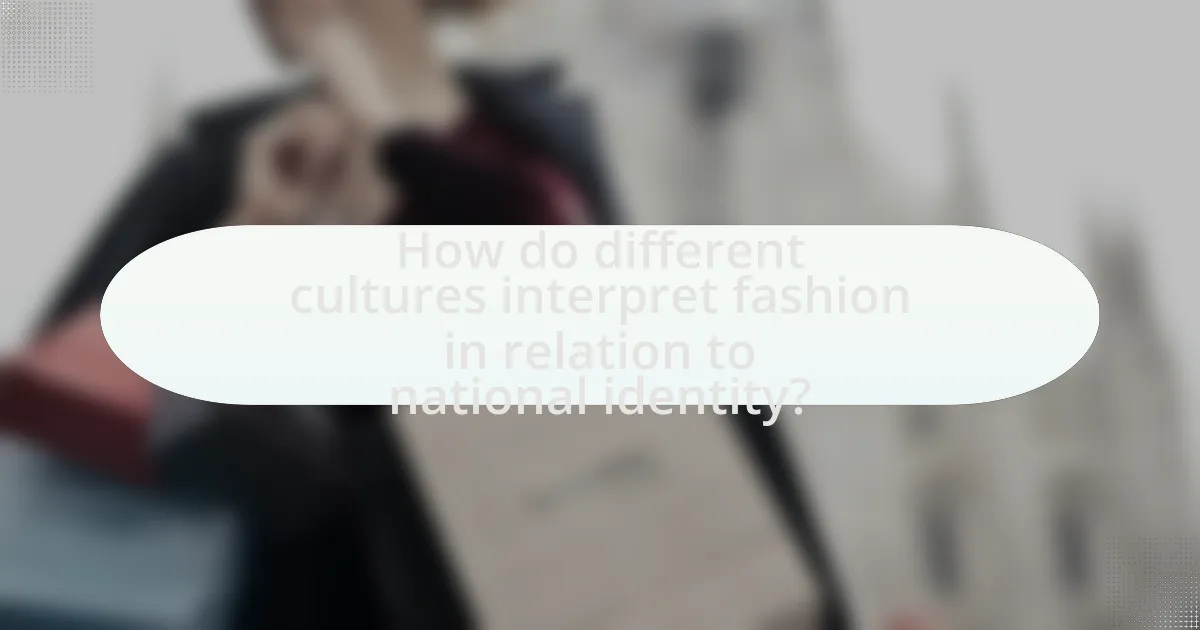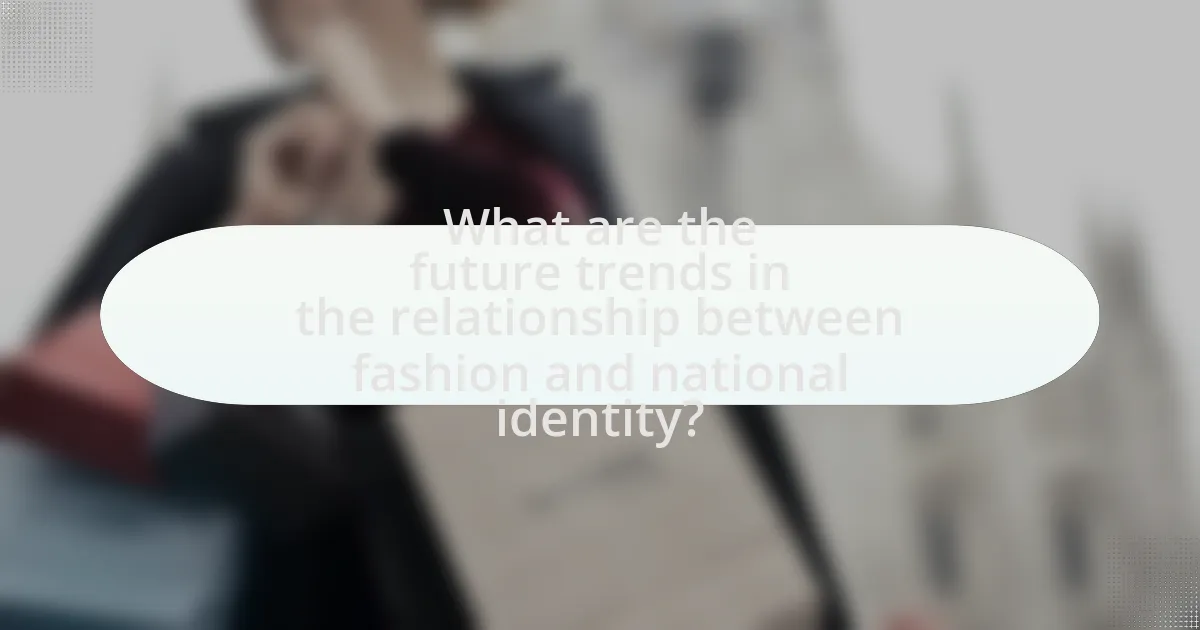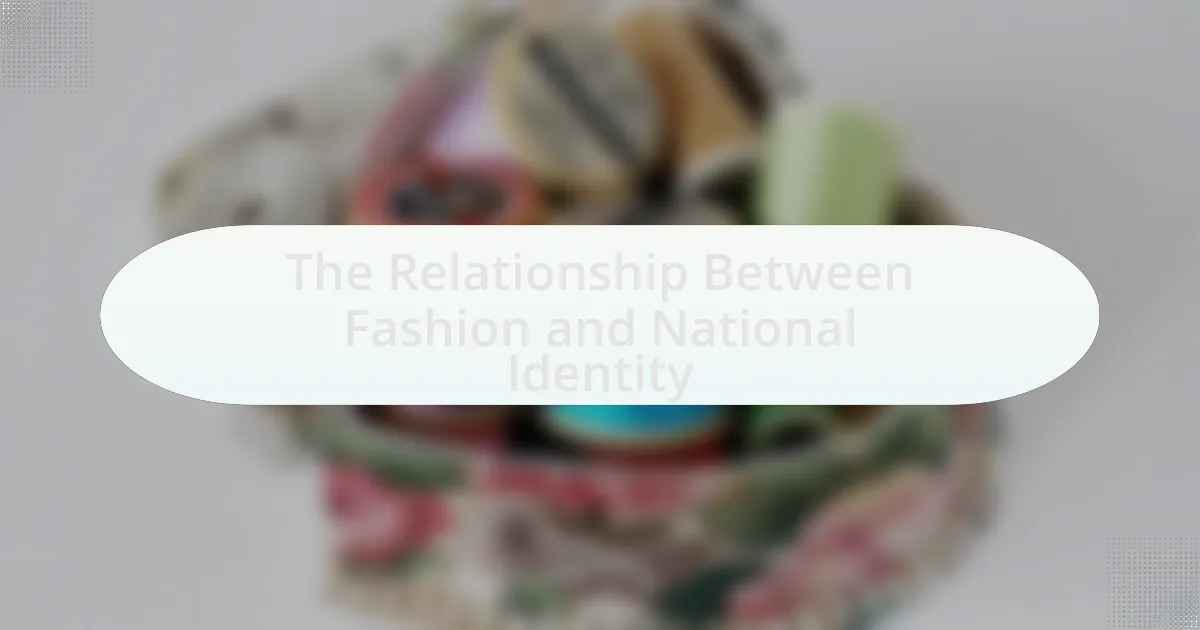The article examines the relationship between fashion and national identity, highlighting how clothing serves as a reflection of cultural values, traditions, and social norms. It discusses the significance of traditional garments, symbols, and motifs in expressing national and unity, as well as the influence of historical events on fashion trends. Additionally, the article explores the impact of globalization on national fashion identities, the role of fashion in self-expression and group identity, and the challenges of maintaining cultural heritage in a globalized market. It also addresses how contemporary designers incorporate national identity into their collections and the future trends in sustainable fashion that reflect cultural narratives.

What is the relationship between fashion and national identity?
Fashion serves as a significant expression of national identity by reflecting cultural values, traditions, and social norms. National identity is often conveyed through traditional garments, symbols, and styles that embody the history and heritage of a nation. For instance, the kimono in Japan represents cultural heritage, while the tartan patterns in Scotland signify clan identity. Studies indicate that fashion can reinforce national and unity, as seen during national celebrations where traditional attire is prominently displayed. Additionally, global fashion trends can influence and reshape national identity, as countries adapt and integrate international styles while maintaining unique cultural elements. This dynamic interplay illustrates how fashion is both a mirror and a mold of national identity.
How does fashion reflect cultural values and beliefs?
Fashion reflects cultural values and beliefs by serving as a visual representation of societal norms, traditions, and identities. For instance, traditional garments like the kimono in Japan or the sari in India embody historical significance and cultural heritage, showcasing the values of respect, modesty, and community. Additionally, fashion trends often emerge in response to social movements, such as the adoption of punk styles in the 1970s, which symbolized rebellion and individualism against mainstream culture. This connection between fashion and cultural identity is further evidenced by studies indicating that clothing choices can influence perceptions of social status and group belonging, reinforcing the idea that fashion is a powerful medium for expressing and shaping cultural narratives.
What symbols and motifs are commonly used in national fashion?
National fashion commonly incorporates symbols and motifs that reflect cultural heritage, identity, and historical significance. For instance, traditional patterns such as paisley in Scottish tartans or floral designs in Mexican textiles often represent regional identities and historical narratives. Additionally, national colors and emblems, like the stars and stripes in American fashion or the tricolor in French attire, serve as powerful symbols of national and unity. These motifs not only enhance the aesthetic appeal of clothing but also communicate deeper meanings tied to cultural values and collective memory, reinforcing the relationship between fashion and national identity.
How do historical events shape national fashion trends?
Historical events significantly shape national fashion trends by influencing cultural values, social norms, and economic conditions. For instance, the aftermath of World War II led to the emergence of the New Look in the 1940s, characterized by feminine silhouettes that reflected a desire for renewal and optimism in post-war society. Additionally, the Civil Rights Movement in the 1960s inspired fashion choices that symbolized empowerment and resistance, such as the adoption of African-inspired styles and the popularity of denim as a working-class symbol. These examples illustrate how pivotal moments in history can directly impact the aesthetics and meanings associated with national fashion, reinforcing the connection between clothing and collective identity.
Why is fashion considered a form of self-expression in national identity?
Fashion is considered a form of self-expression in national identity because it allows individuals to convey cultural values, heritage, and personal beliefs through their clothing choices. This expression is evident in traditional garments that symbolize national , such as the kimono in Japan or the sari in India, which reflect historical significance and cultural narratives. Additionally, fashion can serve as a medium for social commentary, enabling individuals to challenge or reinforce societal norms related to their national identity. For instance, during political movements, clothing styles can signify solidarity or resistance, as seen in the use of specific colors or symbols. Thus, fashion acts as a visual language that articulates one’s connection to their national identity while also allowing for personal interpretation and expression.
How do individuals use fashion to convey their national identity?
Individuals use fashion to convey their national identity by incorporating traditional garments, colors, and symbols that represent their culture and heritage. For example, wearing a kimono in Japan or a sari in India signifies a connection to national traditions and values. This practice is supported by studies showing that clothing choices often reflect cultural and social belonging, as seen in events like national holidays or cultural festivals where specific attire is worn to celebrate identity.
What role does fashion play in the formation of group identity?
Fashion plays a crucial role in the formation of group identity by serving as a visual marker that signifies belonging and shared values among individuals. Through specific styles, colors, and symbols, fashion communicates group affiliation and cultural heritage, reinforcing social bonds. For example, research by sociologist Thorstein Veblen highlights how clothing choices reflect social status and group membership, illustrating that individuals often adopt particular fashion trends to align with their social circles. Additionally, studies show that uniforms in various contexts, such as schools or organizations, create a sense of unity and collective identity, further emphasizing the importance of fashion in group dynamics.
In what ways does globalization impact national fashion identities?
Globalization impacts national fashion identities by facilitating the exchange of cultural influences, leading to hybrid styles that blend local traditions with global trends. This phenomenon is evident in the rise of fast fashion brands, which often incorporate elements from various cultures, thereby altering traditional fashion practices. For instance, the popularity of streetwear, which merges urban aesthetics from different countries, showcases how globalization can dilute distinct national styles while simultaneously creating new, globally recognized identities. Additionally, the accessibility of international fashion through digital platforms allows consumers to adopt and adapt styles from around the world, further reshaping their national fashion identities.
How do global fashion trends influence local styles?
Global fashion trends significantly influence local styles by introducing new designs, materials, and aesthetics that local designers and consumers adopt. This influence occurs through various channels, including social media, international fashion shows, and global retail brands that disseminate trends worldwide. For instance, the rise of streetwear, which originated in urban centers like New York and Tokyo, has been embraced by local fashion scenes globally, leading to the incorporation of elements such as oversized silhouettes and graphic tees into traditional attire. Additionally, a study by the Fashion Institute of Technology found that 70% of consumers in diverse regions reported being influenced by global fashion trends when making local purchasing decisions, demonstrating the pervasive impact of these trends on local fashion identities.
What are the challenges of maintaining national identity in a globalized fashion market?
Maintaining national identity in a globalized fashion market presents significant challenges, primarily due to the homogenization of styles and cultural influences. Global brands often dominate local markets, leading to a dilution of traditional attire and local craftsmanship. For instance, the rise of fast fashion has resulted in consumers favoring mass-produced clothing over locally made garments, which can erode cultural heritage. Additionally, the pervasive influence of social media and international trends can overshadow local fashion narratives, making it difficult for national identities to assert themselves. This phenomenon is evident in countries where traditional clothing is increasingly viewed as outdated in favor of Western styles, impacting cultural and continuity.

How do different cultures interpret fashion in relation to national identity?
Different cultures interpret fashion as a reflection of national identity by using clothing styles, colors, and symbols that embody cultural heritage and values. For instance, traditional garments like the kimono in Japan or the sari in India serve not only as attire but also as representations of cultural history and social status. These garments often incorporate specific patterns and colors that hold significant meaning within the culture, reinforcing a sense of belonging and .
Moreover, fashion can act as a medium for political expression; for example, the use of national colors in clothing during protests or celebrations can unify individuals under a shared identity. Studies have shown that fashion choices can influence perceptions of national identity, as seen in the global popularity of brands that emphasize local craftsmanship and cultural narratives. This connection between fashion and national identity is evident in events like national holidays, where traditional attire is prominently worn, showcasing the cultural significance of fashion in expressing national and unity.
What are some examples of traditional clothing that represent national identity?
Traditional clothing that represents national identity includes the kimono from Japan, the sari from India, and the kilt from Scotland. The kimono, characterized by its intricate designs and rich fabrics, symbolizes Japanese culture and heritage, often worn during festivals and ceremonies. The sari, a long piece of cloth draped elegantly, reflects India’s diverse cultural tapestry and is worn by women across various regions, showcasing regional styles and traditions. The kilt, a knee-length skirt-like garment made of tartan fabric, is emblematic of Scottish identity, often associated with clan heritage and worn during formal events and celebrations. Each of these garments serves as a powerful representation of their respective nations, embodying cultural values, history, and social significance.
How do traditional garments vary across different cultures?
Traditional garments vary significantly across different cultures, reflecting unique histories, values, and social norms. For instance, the kimono in Japan symbolizes elegance and tradition, often worn during ceremonies, while the sari in India represents grace and cultural identity, typically draped in various styles depending on the region. In Scotland, the kilt serves as a symbol of national and heritage, often associated with clan identity. These garments not only serve functional purposes but also convey messages about social status, community belonging, and cultural heritage. The diversity in traditional attire illustrates how clothing can embody the essence of a culture, showcasing its distinctiveness and the values it holds dear.
What significance do these garments hold in cultural celebrations?
Garments hold significant cultural value in celebrations as they symbolize identity, heritage, and community belonging. These clothing items often reflect traditional craftsmanship, colors, and patterns that are unique to specific cultures, reinforcing a sense of and continuity among participants. For instance, the use of kimono in Japanese festivals showcases the country’s rich history and aesthetic values, while the vibrant attire worn during Diwali in India represents joy and the triumph of light over darkness. Such garments not only enhance the visual spectacle of celebrations but also serve as a medium for storytelling and the transmission of cultural values across generations.
How do contemporary designers incorporate national identity into their collections?
Contemporary designers incorporate national identity into their collections by utilizing traditional motifs, fabrics, and cultural symbols that reflect their heritage. For instance, designers often draw inspiration from indigenous patterns or historical garments, integrating these elements into modern silhouettes to create a dialogue between past and present. A notable example is the use of African prints by designers like Stella Jean, who blends these textiles with contemporary styles to celebrate her Italian-Haitian roots. This approach not only honors cultural heritage but also promotes a sense of belonging and among consumers, reinforcing the connection between fashion and national identity.
What are some notable fashion designers known for their cultural representation?
Notable fashion designers known for their cultural representation include Vivienne Westwood, who incorporates British punk culture into her designs, and Issey Miyake, recognized for his innovative use of traditional Japanese techniques. Additionally, Stella Jean blends Italian craftsmanship with Haitian heritage, while Dapper Dan is celebrated for his influence on Harlem culture through luxury streetwear. These designers exemplify how fashion can reflect and celebrate diverse cultural identities, contributing to a broader understanding of national identity in the fashion industry.
How do fashion shows highlight national identity themes?
Fashion shows highlight national identity themes by showcasing traditional garments, cultural symbols, and design aesthetics that reflect a country’s heritage. For instance, designers often incorporate indigenous textiles, patterns, and motifs that resonate with national history and cultural narratives. This practice not only celebrates local craftsmanship but also fosters a sense of and belonging among the audience. Events like the Paris Fashion Week frequently feature collections inspired by the designer’s cultural background, reinforcing the connection between fashion and national identity. Such representations serve as a visual dialogue about cultural values and societal norms, making fashion a powerful medium for expressing and preserving national identity.
What role does fashion play in national and patriotism?
Fashion serves as a significant expression of national and patriotism by embodying cultural identity and heritage. National attire often reflects historical narratives, traditional craftsmanship, and local materials, fostering a sense of belonging among citizens. For instance, during national celebrations, people frequently wear traditional garments, which reinforces collective identity and unity. Studies have shown that countries with strong fashion industries, such as Italy and France, utilize fashion as a means to promote national culture globally, enhancing their international image and fostering among citizens. This connection between fashion and national identity is evident in events like national holidays, where specific clothing styles symbolize patriotism and cultural values.
How do national events influence fashion choices among citizens?
National events significantly influence fashion choices among citizens by fostering a sense of unity and cultural identity. For instance, during national holidays or celebrations, citizens often wear traditional attire or colors that represent their country, reinforcing national . Historical examples include the widespread adoption of red, white, and blue clothing during American Independence Day celebrations, which reflects patriotism and collective identity. Additionally, events like the Olympics see nations encouraging their citizens to don national colors and symbols, promoting a shared identity and solidarity. This connection between national events and fashion choices illustrates how cultural moments shape individual and collective expressions of identity through clothing.
What impact does fashion have on tourism related to national identity?
Fashion significantly impacts tourism by shaping and expressing national identity, attracting visitors who seek authentic cultural experiences. Tourists often associate specific styles, traditional garments, and fashion trends with a country’s heritage, which enhances their desire to explore and engage with that culture. For instance, events like Paris Fashion Week not only showcase French fashion but also draw millions of tourists, reinforcing France’s identity as a global fashion capital. Additionally, research indicates that local fashion influences tourists’ perceptions, as seen in studies highlighting how traditional attire, such as kimono in Japan, enhances cultural tourism and fosters a deeper understanding of national identity.

What are the future trends in the relationship between fashion and national identity?
Future trends in the relationship between fashion and national identity will increasingly emphasize sustainability and inclusivity. As global awareness of environmental issues rises, fashion brands are likely to adopt eco-friendly practices that reflect national values of stewardship and responsibility. Additionally, the blending of cultural influences through globalization will lead to a more diverse representation of national identities in fashion, allowing for a fusion of traditional and contemporary styles. This trend is supported by the rise of social media, which enables cross-cultural exchanges and promotes local artisans, thereby reinforcing national while embracing global influences.
How is technology shaping the future of fashion and national identity?
Technology is significantly shaping the future of fashion and national identity by enabling personalized and culturally relevant designs through data analytics and artificial intelligence. These technologies allow designers to analyze consumer preferences and cultural trends, leading to the creation of fashion that resonates with specific national identities. For instance, AI-driven platforms can predict fashion trends based on social media data, reflecting the evolving nature of cultural expressions in different countries. Additionally, advancements in digital fabrication, such as 3D printing, empower local artisans to produce unique garments that celebrate their cultural heritage, thus reinforcing national identity. This intersection of technology and fashion not only enhances creativity but also fosters a sense of belonging and in cultural narratives.
What innovations are emerging in sustainable fashion that reflect national identity?
Innovations in sustainable fashion that reflect national identity include the use of traditional textiles and techniques, such as indigenous weaving methods in South America and African batik, which promote cultural heritage while emphasizing eco-friendly practices. For instance, brands like Osklen in Brazil incorporate local materials and craftsmanship, showcasing Brazilian identity through sustainable production methods. Additionally, the rise of circular fashion initiatives, such as the “Make Do and Mend” movement in the UK, emphasizes repairing and reusing garments, aligning with national values of resourcefulness and sustainability. These innovations not only reduce environmental impact but also celebrate and preserve cultural identities, demonstrating a strong connection between sustainable fashion and national .
How do social media platforms influence perceptions of national fashion?
Social media platforms significantly influence perceptions of national fashion by shaping trends, promoting cultural exchange, and amplifying diverse representations. These platforms allow users to share images and videos of fashion styles from various countries, creating a global dialogue about what constitutes national identity in fashion. For instance, Instagram and TikTok have become vital in showcasing local designers and traditional attire, which can lead to a resurgence of interest in national styles. Research indicates that social media can alter consumer behavior, with 54% of users stating they are influenced by social media when making fashion purchases, highlighting its role in shaping perceptions. Additionally, platforms facilitate the blending of cultural elements, leading to hybrid fashion styles that reflect both local and global influences, thus redefining national fashion narratives.
What challenges do designers face in balancing tradition and modernity?
Designers face significant challenges in balancing tradition and modernity, primarily due to the need to respect cultural heritage while appealing to contemporary tastes. This balancing act often leads to conflicts between maintaining authentic traditional elements and integrating modern design principles that resonate with current consumer preferences. For instance, designers may struggle to incorporate traditional textiles or motifs in a way that feels relevant and fresh, risking alienation of both traditionalists and modern consumers. Additionally, the rapid pace of fashion trends can pressure designers to prioritize modernity, potentially overshadowing the cultural significance of traditional designs. This tension is evident in various fashion collections that attempt to merge historical influences with innovative techniques, highlighting the ongoing negotiation between honoring the past and embracing the future.
How can designers honor cultural heritage while appealing to global markets?
Designers can honor cultural heritage while appealing to global markets by integrating traditional motifs and techniques into contemporary designs. This approach allows designers to create products that reflect cultural narratives while remaining relevant to global consumer trends. For instance, brands like Gucci and Dior have successfully incorporated elements from various cultures, such as African prints or Asian textiles, into their collections, which not only celebrates diversity but also attracts a broader audience. This strategy is supported by market research indicating that consumers increasingly value authenticity and cultural storytelling in fashion, with 62% of global consumers preferring brands that demonstrate cultural respect and awareness.
What strategies can be employed to promote national identity through fashion?
Strategies to promote national identity through fashion include the incorporation of traditional textiles and motifs into contemporary designs, which helps to celebrate cultural heritage. For instance, designers can utilize indigenous patterns or local craftsmanship to create garments that reflect national . Additionally, organizing fashion events that showcase local designers and their work can foster a sense of community and belonging, as seen in initiatives like the Africa Fashion Week, which highlights African designers and their cultural narratives. Furthermore, collaborations between fashion brands and cultural institutions can enhance awareness of national identity, as evidenced by partnerships that promote local artisans and traditional techniques. These strategies not only elevate national identity but also contribute to the global fashion narrative by emphasizing unique cultural stories.
What practical tips can individuals use to express their national identity through fashion?
Individuals can express their national identity through fashion by incorporating traditional garments, colors, and symbols associated with their culture. Wearing traditional attire, such as a kimono in Japan or a sari in India, showcases cultural heritage and . Additionally, using national colors in everyday clothing, like red, white, and blue in the United States, reinforces a sense of belonging. Accessories, such as jewelry or scarves featuring national motifs or flags, can also serve as subtle yet powerful expressions of identity. These practices are supported by the observation that clothing choices often reflect cultural values and social identity, as noted in studies on fashion and cultural representation.
How can one incorporate traditional elements into everyday wear?
One can incorporate traditional elements into everyday wear by integrating cultural motifs, fabrics, and silhouettes into modern clothing. For instance, wearing garments that feature traditional patterns, such as paisley or ikat, can reflect cultural heritage while remaining stylish. Additionally, using fabrics like silk or handwoven textiles in contemporary designs can bridge the gap between tradition and modernity. Historical evidence shows that many fashion designers, such as Stella Jean, have successfully blended traditional craftsmanship with modern aesthetics, thereby promoting cultural identity through fashion. This approach not only honors heritage but also makes traditional elements accessible and relevant in daily life.
What resources are available for exploring national fashion styles?
Resources available for exploring national fashion styles include academic journals, fashion history books, online databases, and cultural exhibitions. Academic journals such as “Fashion Theory” and “The Journal of Dress History” provide peer-reviewed articles that analyze the intersection of fashion and national identity. Fashion history books, like “The Fashion System” by Roland Barthes, offer insights into how clothing reflects cultural values. Online databases, such as JSTOR and Google Scholar, allow access to a wide range of research articles on fashion studies. Additionally, cultural exhibitions at museums, like the Victoria and Albert Museum in London, showcase traditional garments and contemporary interpretations, illustrating the evolution of national styles.

Leave a Reply